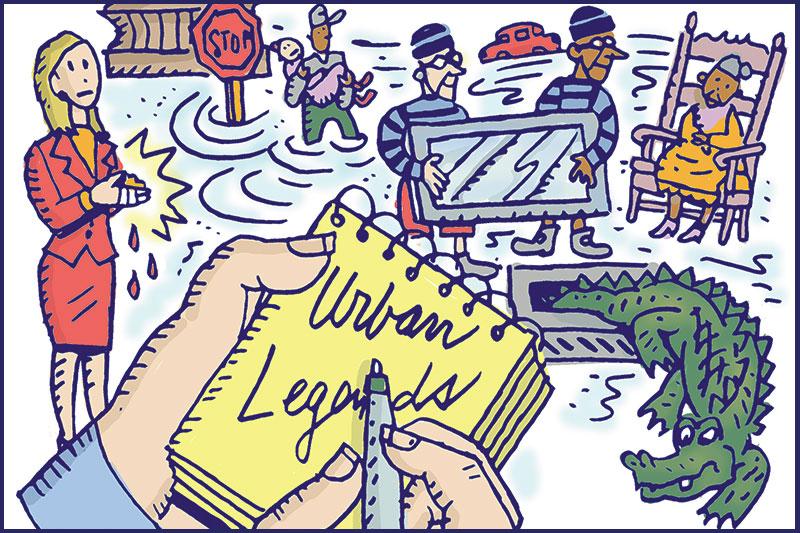Life in the era of fake news
Editor’s note: This article appeared first in the June 2018 issue of Tulane magazine.
The immediate post-Katrina world in this city was the perfect spawning ground for urban myths. The city was underwater, communication was difficult, and for a time it was lawless and without power, therefore very dark at night.
Looters ran amok. One widespread urban myth/legend was that looters broke into an elderly woman’s house when she was there, realized the poor soul had nothing worth stealing, and in a moment of sideways sympathy for her, they went to another dwelling, stole a high-def TV and brought it back to her. Best I can tell this happened everywhere from Lakeview to the Ninth Ward to Uptown. There were also alligators in the storm drains.
It’s the kind of stuff that former Tulane sociology professor Fred Koenig, whose expertise was social psychology, spent a lifetime debunking— rumors, urban myths and hoaxes.
So a short while ago I was perusing the ultimate fount of truthfulness and accuracy—Twitter—when I stumbled onto an attention-grabber. A Tulane medical school graduate, now an established physician in Seattle, had posted a fantastic story that seemed to be the perfect urban myth.
We live in the era of fake news and fractured journalism where believability is constantly in doubt. Figuring out what’s true and not true, what’s news versus opinion, at times is a daunting challenge.
Dr. Eliot Fagley was at Tulane from 1998 through 2005 for med school and his residency and internship. His resume also shows that he was a bartender at the now defunct Le Chat Noir, a CBD playhouse and bar on St. Charles Avenue. “A great place,” he said. He is currently at Virginia Mason Medical Center where he is an anesthesiologist specializing in critical care cardiology surgery, an intensivist. He recalled this: “So I’m dating a med student in 2003 and she says to me, ‘Hey, have you heard this story about a girl in the med school interview room and there was this glass bottle explosion and she was bleeding a lot from her hand during the interview but still continued on?’”
Fagley said he had not, but later heard that the student being interviewed was painting her nails during the interview when this happened. “I didn’t believe it could possibly be true, and honestly I didn’t think about it for maybe 12 years.” He parked it into his brain’s urban myth dormant file.
For the past year and a half, Dr. Fagley’s partner has been Dr. Sarah Bain, a graduate of George Washington Medical School who did her residency and cardiac fellowship in anesthesiology at Stanford. Through a friend, the highly qualified physician had been referred to Dr. Fagley and she came on board. A couple of weeks ago he was sitting at lunch with Sarah Bain when she casually said, “Hey, have I ever told you about my interview at Tulane?”
She went on to say that she was wearing a skirt and panty hose. She had a run in her stocking but she was prepared. Her mom had told her if that happened to put clear nail polish on it. She tried to open the bottle but the whole thing exploded and severely cut her hand. She sat there and listened to the rest of the briefing.
Then she excused herself and went to the ladies room, leaving a trail of blood behind her. She wrapped her hand in paper towels, returned to the room and said, “I’ve got this problem.” Fagley said she told him that when the lady looked at it, she almost passed out. Bain was taken to the ER where she was stitched up but suffered nerve damage for years.
Dr. Fagley’s reaction was, “‘You have got to be kidding me? That was you?’ We’d been working together for a year and a half and she only told me two weeks ago? It’s a crazy story, but it was no urban myth.”
Not that he didn’t believe his partner, but like any good journalist would do, he was seeking affirmation. So he contacted the senior associate dean for student affairs at Tulane medical school, Dr. Marc Kahn, and asked him if he remembered a girl who cut herself during an interview.
“You mean Sarah Bain?” Kahn replied without hesitation.
In what may qualify for the understatement of the year, Dr. Fagley said, “The likelihood of the two of us crossing paths is infinitesimally small.”
Something like California’s Sasquatch meeting Louisiana’s Rougarou in Kansas.

